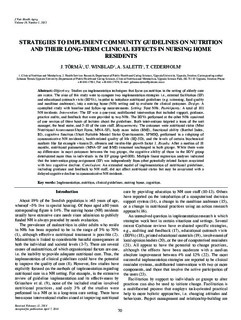| dc.contributor.author | Törmä, Johanna | |
| dc.contributor.author | Winblad, Ulrika | |
| dc.contributor.author | Saletti, Anja | |
| dc.contributor.author | Cederholm, Tommy | |
| dc.date.accessioned | 2018-03-22T13:47:42Z | |
| dc.date.available | 2018-03-22T13:47:42Z | |
| dc.date.issued | 2015 | |
| dc.identifier.citation | Törmä, J., Winblad, U., & Saletti, A., & Cederholm, T. (2015). Strategies to implement community guidelines on nutrition and their long-term clinical effects in nursing home residents. The journal of nutrition, health & aging, 19(1), 70-76. | nb_NO |
| dc.identifier.uri | http://hdl.handle.net/11250/2491761 | |
| dc.description.abstract | Objectives: Studies on implementation techniques that focus on nutrition in the setting of elderly care are scarce. The aims of this study were to compare two implementation strategies i.e., external facilitation (EF) and educational outreach visits (EOVs), in order to introduce nutritional guidelines (e.g. screening, food quality and mealtime ambience), into a nursing home (NH) setting and to evaluate the clinical outcomes.
Design: A controlled study with baseline and follow-up measurements.
Setting: Four NHs.
Participants: A total of 101 NH residents.
Intervention: The EF was a one-year, multifaceted intervention that included support, guidance, practice audits, and feedback that were provided to two NHs. The EOVs performed at the other NHs consisted of one session of three hours of lectures about the guidelines. Both interventions targeted a team of the unit manager, the head nurse, and 5--10 of the care staff.
Measurements: The outcomes were nutritional status (Mini Nutritional Assessment-Short Form, MNA-SF), body mass index (BMI), functional ability (Barthel Index, BI), cognitive function (Short Portable Mental Status Questionnaire, SPMSQ, performed in a subgroup of communicative NH residents), health-related quality of life (EQ-5D), and the levels of certain biochemical markers like for example vitamin D, albumin and insulin-like growth factor 1.
Results: After a median of 18 months, nutritional parameters (MNA-SF and BMI) remained unchanged in both groups. While there were no differences in most outcomes between the two groups, the cognitive ability of those in the EOV group deteriorated more than in individuals in the EF group (p=0.008). Multiple linear regression analyses indicated that the intervention group assignment (EF) was independently from other potentially related factors associated with less cognitive decline.
Conclusion: An extended model of implementation of nutritional guidelines, including guidance and feedback to NH staff, did not affect nutritional status but may be associated with a delayed cognitive decline in communicative NH residents. | nb_NO |
| dc.publisher | The Journal of Nutrition, Health & Aging | nb_NO |
| dc.subject | implementation | nb_NO |
| dc.subject | nutrition | nb_NO |
| dc.subject | clinical guidelines | nb_NO |
| dc.subject | nursing homes | nb_NO |
| dc.subject | cognition | nb_NO |
| dc.title | Strategies to implement community guidelines on nutrition and their long-term clinical effects in nursing home residents | nb_NO |
| dc.type | Journal article | nb_NO |
| dc.source.pagenumber | 70-76 | nb_NO |
| dc.source.volume | 19 | nb_NO |
| dc.source.journal | The Journal of Nutrition, Health & Aging | nb_NO |
| dc.source.issue | 1 | nb_NO |
| dc.identifier.doi | 10.1007/s12603-014-0522-4 | |
